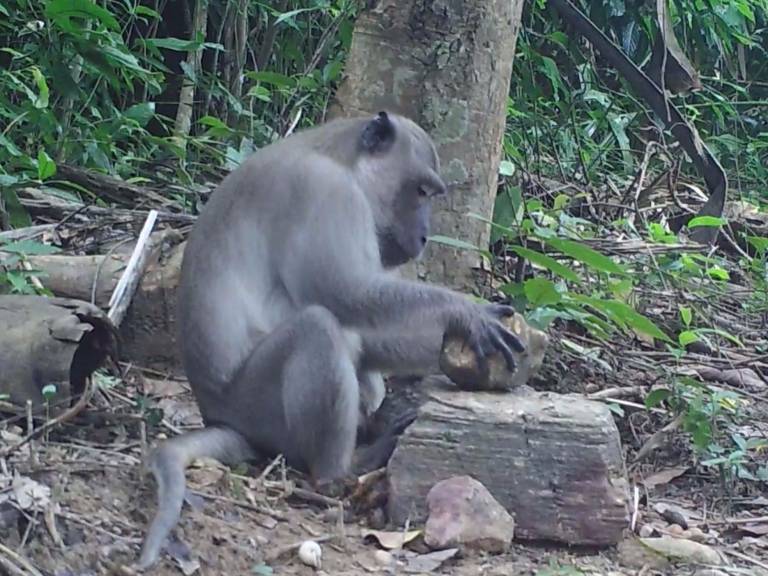Macaques choose stone tools based on own size and strength
21 March 2018
Macaques appear to select stone tools to crack open oil palm nuts based on the size and strength of their own body, rather than the optimum weight and size of the stone, to make the process more efficient, according to new research led by UCL.

In the paper published in the Royal Society Open Science, researchers from UCL, the University of Oxford, Oxford Brookes University, Chulalongkorn University (Bangkok, Thailand) and Nanyang Technological University (Singapore), have, for the first time, described the stone tools used by wild long-tailed macaque monkeys in southern Thailand to crack open nuts.
"The stone tools we've uncovered show a high degree of battering and crushing on most surfaces. Interestingly, the stone tools are smaller than those used by wild chimpanzees for processing the same nut, and are smaller than those used by wild macaques to process another encased plant food, sea almonds." said study lead Dr Tomos Proffitt (UCL Archaeology).
"These new findings should help us to understand and compare skill levels between macaques and chimpanzees during tool use, and to assess differences in tool selection and mode of use." added Dr Proffitt.
The research team say this is an important step forward in the emerging field of primate archaeology, as it increases our understanding of how different non-human primates use stone tools in the wild, and may allow future insights into how early human ancestors developed and used stone tools.
To date only chimpanzees in Western Africa have been observed to open oil palm nuts using a stone hammer and anvil, a behaviour some have suggested may be similar to the one that lead humans to develop stone tool technology nearly 3.3 million years ago.
Last year, however, a team led by Dr Lydia Luncz of Oxford University, recorded wild long-tailed macaque monkeys on Yao Noi Island in Ao Phang Nga National Park using stone hammers and anvils to crack open hard shelled oil palm nuts in a similar way to that observed with chimpanzees.
Oil palm nuts are not native to the islands, but were first introduced by humans in the past few decades. Traditionally macaques focused on oysters by the sea for food intake, but when humans left, the macaques moved inland demonstrating a new adaptive behaviour.
This new follow-up study led by Dr Tomos Proffitt from UCL, presents the stone tools used by these macaques, and characterises the damage produced by this behaviour. By applying archaeological techniques used in the study of primates and tool use, the researchers can study primate behaviour even when direct observation of the monkeys is impossible.
"Our findings suggest that macaques are choosing stones that mirror the landscape. For example, where there is a lot of limestone in the landscape, we observe more limestone stone tools. It appears that macaques are choosing stones based on what raw material is available rather than the best material for the job, but this is where we will develop our research to further understanding." The research was funded by the European Research Council starting grant, a British Academy Fellowship, Leverhulme Research Grant and a National Geographic Waitt Grant.
Links
Image
- Male long tailed macaque cracking oil palm nuts. Photo credit: Dr Lydia Luncz, University of Oxford.
Media contact
Natasha Downes
Tel: +44 (0)20 3108 3844
Email: n.downes [at] ucl.ac.uk
 Close
Close

